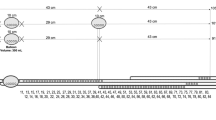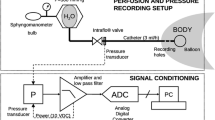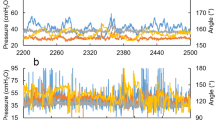Abstract
Ultra slow waves (USW's) in the anal canal are discrete pressure fluctuations with a low frequency (1–2/minute) and high amplitude (≥10% above or below baseline resting pressure). To investigate the nature of these USW's, anorectal manometry was performed in 20 control subjects as well as in 58 patients presenting with anal fissure or symptomatic hemorrhoids, before and 2 weeks after lateral internal sphincterotomy. USW's could be demonstrated in two control subjects and in 29 patients. The median value of maximum anal resting pressure (MARP) in the two control subjects with USW's was significantly higher than the median MARP in the 18 control subjects without USW's (181.5 vs. 92 cm H2O, p<0.001, two-tailed Mann-Whitney test). The same difference was found between MARP in patients with and without USW's (158 vs. 138 cm H2O, p<0.05, two-tailed Mann-Whitney test). All patients were treated by means of lateral internal sphincterotomy (LIS). Two weeks after this procedure USW's had disappeared in half of the patients. The MARP in these patients was reduced to a level found in control subjects without USW's. This pressure reduction was significantly greater than in patients with persistent USW's (40% vs. 15%, p<0.02, two-tailed Mann-Whitney test). Because USW's are associated with high MARP and disappear when such a high anal canal resting pressure is reduced by LIS to a level found in control subjects without USW's, it can be concluded that USW's are the manifestation of increased activity of the internal anal sphincter.
Résumé
Les ondes ultra lentes (OUL) dans le canal anal sont des fluctuations de pression discrêtes avec une fréquence basse (1–2 minute) et de grande amplitude (≥à 10% au-dessus ou au-dessous de la ligne de base de la pression de repos). Pour étudier la nature de ces OUL une manométrie ano-rectale a été effectuée chez 20 sujets contrôles aussi bien que chez 58 malades présentant une fissure anale ou des hémorroïdes symptomatiques avant et deux semaines après une sphinctérotomie latérale interne. Des OUL peuvent être démontrées chez 2 sujets contrôles et chez 29 malades. La valeur moyenne de la pression anale de repos maximal (PARM) chez les 2 sujets contrôle avec des OUL était significativement plus élevée que la PARM moyenne des 18 contrôles sans OUL (181.5 vs 92 cm H2O, p<0.001, test de Mann-Whitney). La même différence a été trouvée entre la PARM des malades avec et sans OUL (158 vs 138 cm H2O, p<0.05, test de Mann-Whitney). Tous les malades ont été traités par sphinctérotomie latérale interne (SLI). Deux semaines après cette intervention les OUL avaient disparu chez la moitié des patients. La PARM de ces patients était réduite au niveau de celle trouvée chez les sujets contrôles sans OUL. Cette réduction de pression était significativement plus grande que chez les patients dont les OUL persistaient (40% vs 15%, p<0.02, test de Mann-Whitney). Du fait que les OUL sont associées avec une PARM élevée et disparaissent quand cette pression de repos élevée est réduite par SLI à un niveau trouvé chez les contrôles sans OUL, il peut être conclu que les OUL sont la manifestation d'une activité accrue du sphincter anal interne.
Similar content being viewed by others
References
Hancock BD (1976) Measurement of anal pressure and motility. Gut 17:645–651
Wankling WJ, Brown BH, Collins CD, Duthie HL (1968) Basal electrical activity in the anal canal in man. Gut 9:457–460
Kerremans R (1969) Morphological and physiological aspects of anal continence and defaecation. Editions Arsica, Brussels
Bouvier M, Gonella J (1981) Nervous control of the internal anal sphincter of the cat. J Physiol 310:457–469
Haynes WG, Read NW (1982) Anorectal activity in man during rectal infusion of saline: a dynamic assessment of the anal continence mechanism. J Physiol 330:45–56
Hancock BD (1981) Lord's procedure for haemorrhoids: a prospective anal pressure study. Br J Surg 68:729–730
Read MG, Read NW, Haynes WG, Donnelly TC, Johnson AG (1982) A prospective study of the effect of haemorrhoidectomy on sphincter function and faecal continence. Br J Surg 69:396–398
El-Gendi MAF, Abdel-Baky N (1986) Anorectal pressure in patients with symptomatic hemorrhoids. Dis Colon Rectum 29:388–391
Arabi Y, Gatehouse D, Alexander-Williams J (1977) Rubber band ligation or lateral subcutaneous sphincterotomy for treatment of haemorrhoids. Br J Surg 64:737–740
Author information
Authors and Affiliations
Rights and permissions
About this article
Cite this article
Schouten, W.R., Blankensteijn, J.D. Ultra slow wave pressure variations in the anal canal before and after lateral internal sphincterotomy. Int J Colorect Dis 7, 115–118 (1992). https://doi.org/10.1007/BF00360348
Accepted:
Issue Date:
DOI: https://doi.org/10.1007/BF00360348




